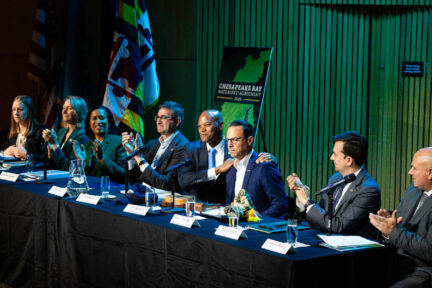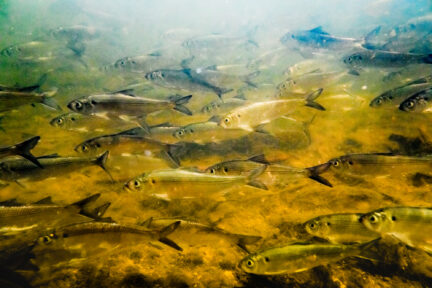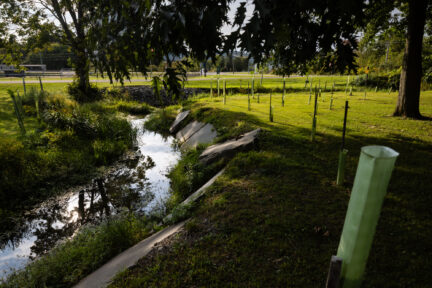Bay Barometer notes measured progress in health of Chesapeake Bay
Today, the Chesapeake Bay Program released its annual report on the environmental health and restoration of the Chesapeake Bay watershed.
Today, the Chesapeake Bay Program released its annual report on the environmental health and restoration of the Chesapeake Bay watershed. Working across political and geographic boundaries, our partnership has reached—and in some cases, surpassed—the halfway mark toward half a dozen of the commitments built into the Chesapeake Bay Watershed Agreement and is cautiously optimistic about the work that remains. Our partnership has renewed its emphasis on engaging landowners and local governments in achieving our vision of a sustainable watershed, and we stand with federal agencies, states, academic institutions and nongovernmental organizations in a united front against risks and threats.
The Chesapeake Bay Program is a regional partnership of federal, state and local governments, academic institutions and non-governmental organizations that lead and direct the restoration and protection of the Chesapeake Bay. Bay Barometer: Health and Restoration in the Chesapeake Bay Watershed (2015-2016) is a science-based snapshot of the nation’s largest estuary and features data and information gathered by the Bay Program’s many partners. This data informs different individuals and organizations, most notably the Chesapeake Bay Foundation’s bi-annual State of the Bay report and the University of Maryland Center for Environmental Science’s Chesapeake Bay Report Card. Earlier this month, CBF graded the Chesapeake Bay a ‘C –’ and in May 2016, the University of Maryland Center for Environmental Science graded it a ‘C’.
“Over the past several years, assessments from three independent organizations – the Chesapeake Bay Program partnership, the University of Maryland Center for Environmental Science and the Chesapeake Bay Foundation – have noted noticeable and steady improvement in a number of important health and restoration indicators in the Chesapeake Bay watershed and its ecosystem” said Nick DiPasquale, Director of the Chesapeake Bay Program. “This confirms that our collective efforts to reduce pollution and restore balance to this important ecosystem are having their intended effect. The challenge now is to step up and sustain these efforts over the long term to ensure continued progress in light of population increases and attendant growth and to offset impacts associated with climate change and other shifting conditions.”
Ecosystem Resiliency
The indicators of environmental health, restoration and stewardship summarized in Bay Barometer reveal a resilient Chesapeake Bay. The data in this report reflect the Bay’s health over the course of many years and, in some cases, decades. In 2016, for instance, an analysis of the first oyster reefs to be built and seeded with larvae in Harris Creek, Maryland showed that all reefs met the minimum criteria for success in oyster weight and density, and half met even higher weight and density targets. In the same year, an annual count of blue crabs revealed the population of adult females had reached its highest total of the last five years and was just ten percent below the restoration target. In 2015, underwater grass abundance reached its highest total of the last three decades and surpassed the 2017 target two years ahead of schedule. The continued health of underwater grass beds, the restoration of native oyster reefs and the sustainable management of fish and shellfish will benefit local seafood economies, but will require continued efforts to reduce pollution and protect wildlife habitat.
“After decades studying this remarkable ecosystem, we now know more about the Chesapeake Bay than any comparable coastal ecosystem in the world,” said Don Boesch, President of the University of Maryland Center for Environmental Science. “This latest report reassures us that long-term efforts to reduce pollution are working, but we can’t be complacent. Science is still needed to guide and monitor the recovery.”
Reducing Pollution, Protecting Land
Federal, state and local agencies are often on the front lines of pollution control. The pollution-reducing practices that states have put in place—including upgrading wastewater treatment plants, lowering vehicle and power plant emissions, and reducing runoff from farmland—are integral in ensuring the Chesapeake Bay meets its Total Maximum Daily Load, or “pollution diet.” A recent analysis shows these practices are in place to achieve 81 percent of the phosphorus reductions, 48 percent of the sediment reductions and 31 percent of the nitrogen reductions needed to reach our clean water goals. Indeed, significant nutrient reductions in the wastewater sector allowed the partnership as a whole to meet its 2025 pollution reduction targets for this sector ten years ahead of schedule.
Federal, state and local agencies also play a critical role alongside nongovernmental organizations and individual landowners in protecting land from development. Between 2010 and 2015, these partners protected more than one million acres, marking an achievement of 50 percent of the target. When fully realized, our protected lands goal will help ensure the watershed can withstand population growth while sustaining the plants, animals and people that live here.
Threats
As the watershed’s population grows, development pressures are dramatically changing the landscape. Urban and suburban development can fragment habitat, harden shorelines, increase impervious surfaces and push pollution into rivers and streams. On the other hand, land use pressures can also open opportunities for dialogue and decision-making to protect ecologically and culturally valuable lands or mitigate damage when impacts are impossible to avoid.
Because public and political attitudes toward conservation vary, approaches to education, engagement and policy must be tailored toward local needs and opportunities. For these reasons, our partnership has placed a renewed emphasis on engaging landowners and local governments in our work to restore forest buffers, wetlands and other habitats, protect land from development, maintain healthy watersheds and more. Most notably, the partnership’s governing body recently signed a resolution to support local government engagement; commended the actions taken by local governments and local utilities to address their pollution reduction goals within the wastewater sectors; and committed to raising awareness about the economic and environmental benefits of investing in watershed protection and restoration efforts at the local level.
“The progress we have made is the result of citizens, businesses and governments all doing their part to reduce pollution and restore water quality,” said Chesapeake Bay Foundation President William C. Baker. “But the job of saving the Bay is not done. We must accelerate efforts to reduce pollution, especially from agriculture and urban and suburban runoff.”



